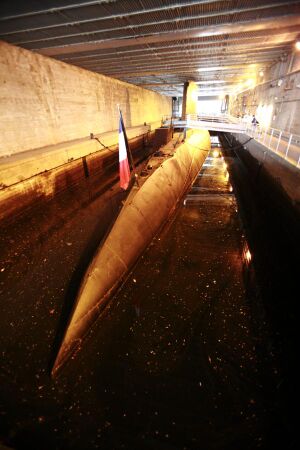Engineering:French Narval-class submarine
 Espadon in Saint-Nazaire
| |
| Class overview | |
|---|---|
| Name: | Narval class |
| Operators: |
|
| Preceded by: | Aurore class |
| Succeeded by: | Aréthuse class |
| In service: | 1958–1992 |
| Completed: | 6 |
| Retired: | 6 |
| Preserved: | 1 |
| General characteristics | |
| Type: | Submarine |
| Displacement: |
|
| Length: | 78.4 m (257 ft 3 in) |
| Beam: | 7.8 m (25 ft 7 in) |
| Draft: | 5.2 m (17 ft 1 in) |
| Propulsion: |
|
| Speed: |
|
| Range: | 15,000 nautical miles (28,000 km) at 8 knots (15 km/h) |
| Test depth: | 400 m (1,300 ft) |
| Complement: | 63 |
| Armament: | 8 × 550 mm (22 in) torpedo tubes: 6 bow & 2 stern, 14 torpedoes carried |
The Narval class (sous-marins d'escadre, "fleet submarines") were patrol submarines built for the French Navy in the 1950s.
Design
The Narval type was an offspring of the E-48 project, inspired by the German Type XXI U-boats of the Second World War, particularly Roland Morillot which were brought into French service.
Compared to the Type XXI, the Narval class introduced an entirely new schnorchel system and novel detection systems, gained 33% in operational range on electric power (400 nautical miles (740 km; 460 mi), compared to the 290 nmi (540 km; 330 mi) available to the type XXI), and doubled the test depth. The propellers were also particularly studied to minimise noise.
The hulls of the Narvals were assembled from seven 10-metre (33 ft) sections welded together.
The engine were two-stroke diesels made by the French constructor Schneider, which proved unreliable and noisy to the point where the engine section became difficult to man at full power.
From 1966 to 1970, the Narvals underwent extensive modernisation, where their engines were replaced by a diesel-electrical design based on the SEMT-Pielstick 12PA4-185. The two stern torpedo tubes were deleted, electronics were replaced, and the conning tower was replaced by a more modern sail plan from the Daphné class.
Service history
The Narvals were used to explore limits of submarines performances in several ways.

In 1958, Dauphin and Requin broke the 30-day world record of the longest underwater cruise held jointly by the nuclear-powered USS Skate and USS Seawolf, with 32 and 42 days submerged respectively.
In 1964, Espadon and Marsouin sailed up to the 70th parallel north to prepare the first French attempts at navigation under sea ice. These tests were carried out the next year by Dauphin and Narval when they spent a week and a half in the 72nd parallel north.
During her last years, from 1980, Requin was fitted with the sonar system planned for the M4 refit of the SNLE. Similarly, Dauphin was extensively modified from 1986 to be used as a test bed for equipment and sensors to be installed on the Triomphant-class submarines, then under design. When finally decommissioned in 1992, she was the oldest submarine in service. She was later expended as a target ship off Toulon.
In 1985, Espadon became the first French submarine used as a museum ship.
Ships
| Pennant number | Name | Builder | Completed | Decommissioned | Fate |
|---|---|---|---|---|---|
| S631 | Narval | Arsenal de Cherbourg | 1 December 1957 | 1986 | |
| S632 | Marsouin | 1 October 1957 | 1987 | ||
| S633 | Dauphin | 1 August 1958 | 1992 | ||
| S634 | Requin | 1 August 1958 | 1985 | ||
| S637 | Espadon | AC Augustin Normand | 2 April 1960 | 1985 | Museum ship in Saint Nazaire |
| S638 | Morse | AC de la Seine Maritime | 2 May 1960 | 1986 |
See also
References
- Conway's All the World's Fighting Ships 1947–1995
- Les sous-marins d'escadre type Narval
 |

